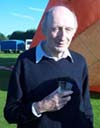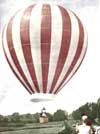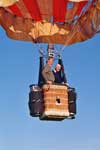
I am often asked how I first got into balloons and I usually blame drink. After qualifying as an aero engineer and having learned to fly on Tiger Moths and later Chipmunks with the University Air Squadron, I turned to gliding as a way to stay airborne. In the bar of the Bristol Gliding Club we began to talk of the new kind of ballooning that had just been invented in USA by Ed Yost and his associates, which we had learned about from the National Geographic Magazine.
It seemed a good idea and we wrote off to the newly established Raven company in South Dakota to ask the price. The quotation we received seemed far too expensive, so we decided to build our own and the project to build the Bristol Belle was started. (By the time we had completed the balloon we realised that the Raven price had been quite reasonable after all!)
Seven members of the group came together. Bill Malpas was slightly older than the rest of us and was elected chairman. Mark Westwood was a Cambridge mathematics graduate and Giles Bulmer was a member of the cider-making family. Mark, Giles and I were in our mid twenties and the four of us were members of the gliding club.
There were three other members. Charles Meisl had been born in Czechoslovakia and had come to England before the war. He ran a motor spares company. Tom Sage was a young press photographer in London who had already made some gas balloon flights. Malcolm Brighton had built a number of balloons and other inflatables and knew more about it than any of us. He was to be the main builder.
In the summer 1966 most of us were present at the Dunstable Air Day. There was a couple of gas balloons there, which took off and disappeared. Then a team from, if I remember, Bolton Technical College, began to prepare their hot air balloon. It was made of polythene inside a string net and carried a rectangular gondola with a very small burner and a single tank. It was inflated part way and it then split, finishing flat on the ground again. The leader of the group made an appeal to the crowd to know if anybody had a roll of Sellotape. Somebody did, and soon they were in action again.
The balloon with the team leader aboard eventually achieved tethered flight and I had the job with others to hold the tether rope. Suddenly to everyone’s consternation it went slack in our hands and the balloon broke into free flight. The pilot sat frozen in the bottom of the gondola as the balloon went up, disappearing into the valley beyond the far side of the airfield. We saw it rise once again and then disappear for good. News came that the pilot was unhurt despite draping the balloon over a power line.
Next that day, was an unmanned Montgolfiere replica restrained by the wire of a glider winch. While the wire was being paid out, all went well enough, but when they tried to reel it in, it parted and the balloon flew on. It came down, puffing smoke, among the parked aeroplanes.
The next item was to be Wing Commander Gerry Turnbull, an experienced gas balloon pilot who was aiming to try out an American balloon that had just been purchased by Leslie Goldsmith. As he was about to begin, a runner arrived with the news that the committee had prohibited any further balloons. He packed up and, although the order was rescinded when it was explained to the committee who the great Wing Commander was, he declined to start again!
Despite all these bad scenes, this was the day when the group fully came together and decided to go ahead. Maybe we thought it must be possible to do it better.

To get initial inflation, we used space-heating blowers known as Jetairs and for many months afterwards we would go to events with two trailers – the second one to carry the Jetairs. On about the second or third inflation, we were shocked when the balloon totally split from the crown right down to the base with two more splits from the crown to the equator. The seriousness of this did not escape us; we realised that, had it lasted a little longer, we might have been at 1000 feet when this had happened, with obvious results.
Mark Westwood and I got down to the job of applying mathematics to the stressing of the envelope and it became clear that the failure was inevitable. There was a stress concentration at the top and the tapes did not continue to take the load. A modification plan was soon made and I took time off work to spend a week at GQ Parachutes in Woking to have the balloon repaired, strengthen the top area and apply a series of horizontal tapes.
We returned once more to Weston on the Green and made our first flight across the airfield on 9 July 1967. A team had arrived from the Daily Telegraph colour supplement and Gerry took a reporter up to the limit of the trailrope which was used as a tether. As he gently descended, the reporter jumped out and the balloon shot up again at high speed. The rope came loose and Gerry made the first flight outside the airfield, landing a couple of fields away.
The first intentional cross-country flight was made on xx/xx/xx. Mark Westwood and I were flying with Gerry supervising. RAF Bicester airfield came in our sights and it seemed a good idea to land there. We did this in the style of a committee with quite a hard bump during which the Wing Commander’s glasses and naval hat that he used for ballooning became detached and passed under the dragging basket. He left us in no doubt about his displeasure at this! This is the first and only time that I have flown a balloon from an airfield to another airfield.
During the next couple of years all seven of us gained our licences. Mine was the first to be issued for hot air balloons only. (I would have preferred to have the last one that was good for all balloons.) A balloon was quite a rarity in those days and we toured the country doing shows. These were mostly quite well paid and held mid-afternoon (we did not know any better).
At a later stage Terry Adams joined the group and famously made a flight with the balloon from the deck of HMS Ark Royal, with a landing in Malta.

Sadly Charles Meisl died a few years ago and Gerry Turnbull has also died in his late eighties. Malcolm Brighton was lost in the early 1970s during an attempt to cross the Atlantic by helium balloon. Otherwise, the rest of us are still surviving, if becoming more and more geriatric as the years pass. The Bristol Belle herself is still around but is in a dreadful condition. It would be unsafe to make even the smallest flight although an inflation should still be possible to celebrate the anniversary.
JMB Manufacturing est. 1994.
JMB Manufacturing imports quality MFC - MDF board - PVC laminates and natural Wood Veneers from Europe for standard & bespoke furniture featured in Auditoriums, Conference Centres, Hotel Rooms, Offices, Reception areas & Sports Halls, inclusive of Desks & Tables, Cabinets, Cupboards, Seating, Screens, Partitions etc
Every order is built to order and a High Specification.
Reliable & realistic delivery dates
are quoted & acheived
For more details - please use the 'Contact' link
Get a price/Spec. comparison - Let us quote you an existing or earlier job?
Would you like a visit?
Just complete the Contact page.
Close Panel
JMB Manufacturing imports quality MFC - MDF board - PVC laminates and natural Wood Veneers from Europe for standard & bespoke furniture featured in Auditoriums, Conference Centres, Hotel Rooms, Offices, Reception areas & Sports Halls, inclusive of Desks & Tables, Cabinets, Cupboards, Seating, Screens, Partitions etc
Every order is built to order and a High Specification.
Reliable & realistic delivery dates
are quoted & acheived
For more details - please use the 'Contact' link
Get a price/Spec. comparison - Let us quote you an existing or earlier job?
Would you like a visit?
Just complete the Contact page.
Close Panel
Close Panel
© Balloon Meet Support Services Ltd. 2010. Webset by & © Genesis-Internet.org
